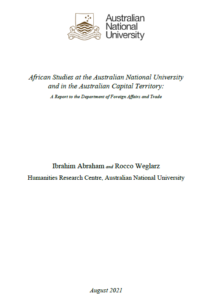Categories
-
ANU Africa Network
Posted on
by
This website was established in 2013 by David Lucas, and renovated and relaunched in 2020 as part of a project to increase awareness of Africa and African studies in the ANU and the ACT, funded by the Australian Government’s Department of Foreign Affairs and Trade.
Another outcome of that project was a major research report, published in August 2021, African Studies at the Australian National University and in the Australian Capital Territory, analyzing the past, present and future of the study of Africa at the Australian National University and the wider Australian University sector.

The major innovation on this updated website is the creation of the ACT Africa Expert Directory which lists experts on Africa from institutions around the ACT, primarily the ANU. We will continue to curate this list, offering a key resource for media, government and non-government organizations seeking expert facts and opinions on Africa. Individuals can request to be added to the list by contacting the website managers.
Another notable addition is the expanded directory of PhD theses on Africa produced in the territory’s universities, a solid measure of the vitality of the study of Africa in the city of Canberra.
Reviewing these directories, it is revealing to note that the vast majority of research on Africa is produced by disciplinary experts (environmental scientists, economists, demographers, etc.) rather than area studies experts. This means that the study of Africa is woven into the fabric of the research culture of the ANU and the ACT’s other universities in ways that are not necessarily apparent.
-
Next Australian Ambassador in Harare
Posted on
by
On January 8th, 2018, the Minister for Foreign Affairs announced the appointment of Ms Bronte Moules as Australia’s next Ambassador to Zimbabwe, with non-resident accreditation to Malawi, the Democratic Republic of the Congo, the Republic of the Congo, and Zambia.
Ms Moules was most recently Deputy High Commissioner to Papua New Guinea.
With regards to Zimbabwe, the Minister stated that ‘We look forward to developing our economic engagement in response to strengthening of rule of law and a more open and market-based investment environment. ‘
.
With regards to all countries to which Ms Moules is accredited the Minister noted that ‘Our private sector engagement, especially in mining, is growing …. ‘Ms Moules holds a Bachelor of Arts from the Australian National University and a Graduate Diploma in Foreign Affairs and Trade.
For more information see:
https://foreignminister.gov.au/releases/Pages/2018/jb_mr_180108.aspx
-
“Development: towards 21st century approaches
Posted on
by
2017 MITCHELL ORATION: “Development: towards 21st century approaches”.
DATE AND VENUE
Monday 04 December 2017 5.30PM–6.30PM
Molonglo Theatre, Level 2, JG Crawford Building 132, Lennox Crossing, ANU
There will be a short reception following the lecture
SPEAKER
Dr Okonjo-Iweala is a development economist has served as Board Chair of Gavi, the Vaccine Alliance, since January 2016. She has twice served as Nigeria’s Finance Minister, most recently between 2011 and 2015. In 2006 she served as Nigeria’s Foreign Affairs Minister, and has also held several key positions at the World Bank, including as Managing Director.
Dr Ngozi Okonjo-Iweala will draw on more than 30 years of development and financial expertise to reflect on the need for a new way forward.
“Are our current approaches to development cooperation fit for purpose to address contemporary challenges? How should development practice evolve to reflect 21st century priorities and knowledge? And how can it bridge the traditional donor-recipient divide? Can aid donors and recipients meaningfully engage with the private sector, private philanthropy, and other new sources of financing?THE MITCHELL ORATION
The Mitchell Oration series, of which this is the fifth, has been created to provide a forum at which the most pressing development issues can be addressed by the best minds and most influential practitioners of our time.
This lecture is presented by the Development Policy Centre at Crawford School of Public Policy, with generous support from the Harold Mitchell Foundation.
TO REGISTER
Enquiries to Shannon Young
Ph: +61 2 6125 7922
-
ANU’s ‘underground astronaut’ finds ancient bones in South Africa
Posted on
by
FROM:
https://www.abc.net.au/news/science/2017-08-26/elen-feuerriegel-the-underground-astronaut/8825148
Four years ago, Dr Elen Feuerriegel was in her first year of a PhD studying human anatomy under the ANU’s Professor Colin Groves, a world renowned paleoanthropologist at The Australian National University.
Trawling the internet she saw an ad. from Professor Berger, a US-born palaeoanthropologist based at the University of Witwatersrand, in South Africa.
It asked for three or four people for a short-term project, but they had to be skinny, preferably small, fit, have some caving experience, a good attitude and be a team player. They could not be claustrophobic.After an interview on Skype Professor Berger concluded that Elen was a wonderful scientist. “She was doing her PhD in Australia, she had the right measure of risk taking versus safety, knowledge, and she had a great understanding of hominin morphology.”
Also “at only 160 centimetres tall, she was also the right size to squeeze through the tightest of the cracks in the cave.”
Two years later, Professor Berger held a press conference to announce that the team had discovered a new species of ancient human in the caves — Homo naledi, naledi being a star in the Sotho language.
After completing her PhD, which included her research on Homo naledi, Elen moved to University of Washington in Seattle.
